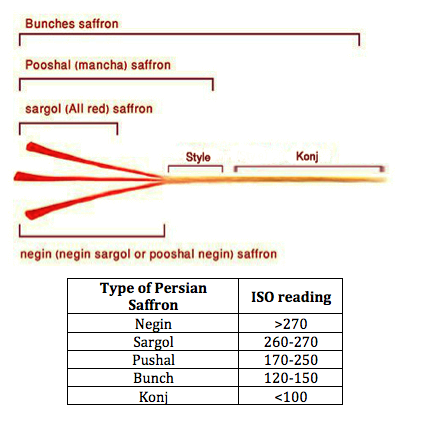![]() Saffron, also known as “Red Gold” is the precious threads from the flower crocus sativus that is plucked and dried to be used mainly in food as condiment due to its unique color, flavor, and aroma.
Saffron, also known as “Red Gold” is the precious threads from the flower crocus sativus that is plucked and dried to be used mainly in food as condiment due to its unique color, flavor, and aroma.
![]() Iran is by far the largest cultivator and producer of saffron in the world, and the northeastern provinces have a share of above 90 percent of the whole production quantity of the country!
Iran is by far the largest cultivator and producer of saffron in the world, and the northeastern provinces have a share of above 90 percent of the whole production quantity of the country!
![]() About 150 flowers are needed to make one gram of dried saffron. When dried, filaments are very light and breakable. Drying can be done naturally under the sun or artificially by using a well-ventilated food dryer in appropriate temperature and right duration.
About 150 flowers are needed to make one gram of dried saffron. When dried, filaments are very light and breakable. Drying can be done naturally under the sun or artificially by using a well-ventilated food dryer in appropriate temperature and right duration.
![]() Besides being a precious food additive, other uses of saffron include its medicinal properties which makes it a natural cure for physical health problems such as indigestion, toothache, menstrual pains, etc.; It is also said to be good for better blood circulation, and is anti-depression.
Besides being a precious food additive, other uses of saffron include its medicinal properties which makes it a natural cure for physical health problems such as indigestion, toothache, menstrual pains, etc.; It is also said to be good for better blood circulation, and is anti-depression.
![]() Based on factors like quality, strength, or levels of crocin / picrocrocin / safranal, Iranian (Persian) saffron can be classified and categorized as Sargol (red stigma tips only / strong grade), Super Negin (longer cuts of red stigma tips with the three strands still together / strongest grade), Pushal (red stigmas with some yellow style / medium grade), Dasteh or Bunch (red stigmas with large amount of yellow style / low grade) as shown in the diagram below:
Based on factors like quality, strength, or levels of crocin / picrocrocin / safranal, Iranian (Persian) saffron can be classified and categorized as Sargol (red stigma tips only / strong grade), Super Negin (longer cuts of red stigma tips with the three strands still together / strongest grade), Pushal (red stigmas with some yellow style / medium grade), Dasteh or Bunch (red stigmas with large amount of yellow style / low grade) as shown in the diagram below:

